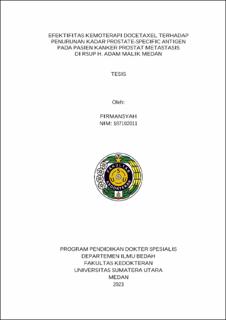| dc.description.abstract | Introduction : Prostate carcinoma is a type of cancer that occurs in a small male gland called the prostate, usually identified by a blood test to measure levels of prostate-specific antigen (PSA), (PSA > 4 ng/ml), a glycoprotein that is usually expressed by prostate tissue and/or digital rectal examination. The chemotherapy treatment route involves the use of drugs such as docetaxel, cabaxitaxel, and mitoxantrone. Docetaxel has been one of the most successful drugs for improving overall survival in metastatic castration-resistant prostate cancer. Typically, docetaxel is administered intravenously every 3 weeks for the recommended 10 cycles. Serum PSA is commonly used in prostate cancer patients to assess response to definitive local therapy, including radical prostatectomy and radiotherapy, to detect recurrence after definitive treatment in localized disease and to monitor response and progression during androgen deprived therapy and chemotherapy in advanced disease.
Methods : The type of research that will be used is observational analytic research with a cross sectional design approach. Data collection was carried out by recording patients with a diagnosis of prostate carcinoma treated with chemotherapy at the Haji Adam Malik Medan General Hospital in the period July - August 2023, and met the inclusion and exclusion criteria. Univariate analysis was performed to describe the characteristics of the variables to be studied including the characteristics of the research subjects in the form of age, cancer cell type, tumor grading, carcinoma stage, and PSA levels before and after chemotherapy. The difference in PSA levels before and after chemotherapy was analyzed by paired T test if the data was normally distributed, and Wilcoxon test if the data was not normally distributed.
Results : The Wilcoxon test, because the data was not normally distributed, showed the difference in PSA levels before and after docsetaxel chemotherapy had a difference of 164.193 + 146.8505 ng/mL with a p value of 0.001 which can be concluded that there is a significant difference. A decrease in PSA levels >50% was found in 12 samples (85.7%), a decrease in PSA levels of 30%-50% was found in 2 samples (14.3%) and there were no samples with a decrease in PSA <30%.
Conclusion : Based on the results of this study, there was a statistically significant difference between PSA levels before and after docsetaxel chemotherapy, with a >50% reduction in PSA levels found in 12 patients (85.7%). | en_US |


